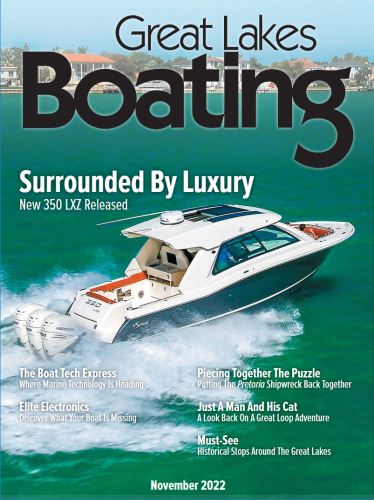.jpg_1600.jpg)
A longtime and respected Lake Minnetonka marina owner announced that a small team’s campaign to change one of the most basic components of pleasure crafting around could save us all from apocalyptic ruin.
That’s right. We’re saying your hull design can stop invasive species. In their tracks.
“A drop of water,” retired US Fish and Wildlife specialist Michael Hoff says, “that is released by a Salty—a commercial shipping vessel that comes into the Great Lakes from the Ocean—can find its way through several diversions around Canada to Louisiana, and have actually moved Hudson Bay water through the country that way. So I’d consider it really a super basin. Hudson Bay Drainage is connected to the Great Lakes which is connected to the Mississippi basin through all those canals.”
But anyone who has read Dan Egan’s book we reviewed in the last issue will know the threat by Salty’s to the Great Lakes is diminishing, and quickly. Gabriel Jabbour’s first hand experiences of hauling boats in and out of the Lakes every season was a vital pivot point.
“But when Gabriel started showing the internal guts of the cooling and other systems in boats, I was stunned by the amount of water that could not be drained readily. So Gabriel educated me and that’s when I, within about five minutes of listening to Gabe, stepped away from the group. I placed a call to some colleagues in Washington DC, saying: This is much worse than I thought it was. We need to deal with this pathway quickly.”
A Little Goes A Long Way
Standing on the shores of Lake Michigan, it’s unfathomable to think that the one gallon of water I pull from the odd corners of my boat could make that much difference. Jabbour is quick to point to a solid analogy, though:
“When we have a flu going around, the attitude is first to ask everyone to wash their hands,” Jabbour said. “Then, we seize on the idea that we could do minor design changes on boats and realize a profound benefit.”
Jabbour, whose Tonka Bay Marina has served as a shoreline laboratory of sorts, was notified that U.S. boat manufacturers and conservation officials have agreed to make the strongest of recommendations on how crafts are designed to limit the spread of invasive species from one body of water to another.
“Whirling disease,” Hoff says, “is a pathogen that you would never see in your gallon of water. Seeds from plants, baby quagga or zebra mussels…the list goes on. If you're moving from a risky body of water to one where none of these invasive species have set up a colony yet, your one gallon of water could be the culprit. Just because you can’t see it, doesn’t mean it's not there.”
Moving The Whole Industry
“The biggest fact, ABYC Technical Director Brian Goodwin says, “is that we can help the industry – in particular, the boat and engine manufacturers – design or retrofit their products to help reduce the spread of AIS by lowering the amount of water residue on a boat once it leaves a lake or river.”
Needless to say, we can expect some boat redesigns coming for the 2019 season, and hopefully some environmentally conscious innovations at Fort Lauderdale in November.
“The whole industry is going to share these new standards and hopefully subscribe to them,” Minnesota’s Premier Pontoons Design Engineer John Deurr said, “Our company has already been doing them, they’re common sense and not that expensive. Until now, we’ve kept these changes to ourselves, but now we want to share them with everybody.”
These design changes include:
- Raising the hull, giving the boat a self-draining aspect while still in the water.
- Placing the jet intake on the boat’s exterior, allowing it to be flushed more effectively with hot water and making the process faster and less difficult.
- Create a “closed” engine cooling system. A side benefit is winterizing at season’s end would be quicker and less expensive.
Key participants in this mission to adjust boat designs for the benefit of industry, regulators and the public include Adam Doll of the Minnesota Department of Natural Resources (DNR), global AIS expert Mike Hoff and Minnesota Gov. Mark Dayton.
For More Information:
ABYC
www.abycinc.org

